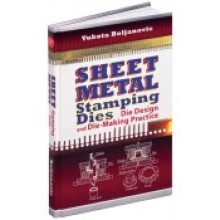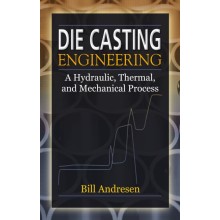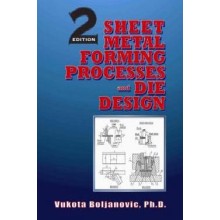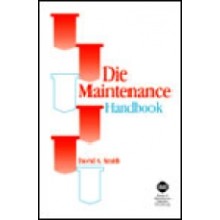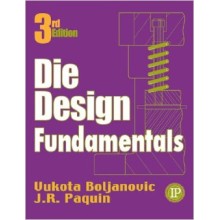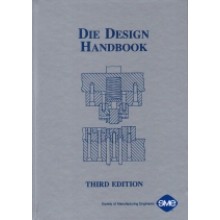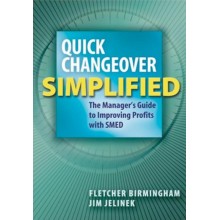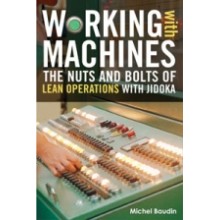Your shopping cart is empty!
Welcome visitor you can login or create an account
Quick Die Change, 2nd Edition
Our Price: $60.00
Quantity:
-
Add to Compare
Quick Die Change pulls together various manufacturing concepts to demonstrate how to achieve dramatic setup time reductions. The book covers not only the basis of changing dies quickly but many fundamental concepts of pressworking that affect the correct changeover of dies.
The book includes chapters on: economic order quantity and just-in-time; training, acceptance, involvement, and support from the workforce; diesetting practice; die clamping methods; die parallels and die locating methods; quick die change strategy; setting progressive dies quickly and accurately; setup of tandem line dies; operating dies at a common shut height; decoiling, straightening, and feeding coil stock; transfer press and die operations; press force monitors; press safeguarding; ergonomics; and training for emergencies and preparedness; unsticking presses; and die maintenance documentation and tracking.
For More Details, Please Check the Contents:
• Preface • Acknowledgments
Chapter 1: Introduction
• History of Quick Die Change • Why we Failed • How Quick Die Change Works • Keep Training Simple • Quick Die Change in a World Economy
Chapter 2: Relationship of QDC to Economic Order Quantity and Just-In-Time
• Pitfalls of Excessive Run-ahead • Working Toward an Economic Order Quantity of One• The Economic Order Quantity Model
• Reducing th EOQ • The Impact on Just-in-Time • Economic Order Quantity Analysis
• Reducing th EOQ • The Impact on Just-in-Time • Economic Order Quantity Analysis
Chapter 3: Training, Acceptance, Involvement, and Support
• The Survival Instinct • Training in Proper Procedures is Essential • Effective Employee Involvement • Respected Experts can be Valuable • Meeting Room Requirements • Training Materials and Instruction • Strategy for Scheduling Training • Union Involvement • Production Management Acceptance • Killing Two Birds with One Stone • Have Students Develop Their OwnWork Rules
• Support is Needed • Support Activities and Responsibilities
• Support is Needed • Support Activities and Responsibilities
Chapter 4: Basic Good Die Setting Practices
• Die Setters • The Die Setter Helps the Operator • Avoid Shortcuts • Good Practices • Improving Die Alignment • Die Locating Methods
Chapter 5: Die Clamping Methods
• Examples of Poor Practices • Mechanical Die Fastening • Threaded Fastener Styles • Die Setting Wrenches • Standardized Clamping Height • Fastening Methods • Power-actuated Die Clamps • Powered Systems versus Manual Bolting
Chapter 6: Die Parallels and Die Locating Methods
• Die Parallels • Die Location
Chapter 7: Quick Die Change Strategy
• Importance of Quick Die Change • Automotive Supplier Case Study
Chapter 8: Grouping Presses and Dies for Quick Die Change
• Evaluating Presses and Dies for Grouping • Dealing with a Mix of Equipment • Every Shop Needs a Plan • Common Press Factors • Using Existing Records • Critical Factors for Running Jobs in the Home Press
Chapter 9: Setting Progressive Dies Quickly and Accurately
• Work Assignment Vary from Shop to Shop • Providing Feedback to the Die Repair Activity • Setting Progressive Dies
• Starting Strips in Progressive Dies • Chutes and Conveyors • Camber Compensation • Designing Dies that Tolerate Cambered Stock • Plan a Good Starting Sequence • Lubrication • Cam Limit Switches • Die Protection Systems • Planning Sequence of Operations • Inductive Proximity Sensors • Photoelectric Sensors
• Starting Strips in Progressive Dies • Chutes and Conveyors • Camber Compensation • Designing Dies that Tolerate Cambered Stock • Plan a Good Starting Sequence • Lubrication • Cam Limit Switches • Die Protection Systems • Planning Sequence of Operations • Inductive Proximity Sensors • Photoelectric Sensors
Chapter 10: Setup of Tandem Line Dies
• Care in Setting Draw and Stretch Form Dies • Bottoming Draw Dies in a Single-action Press • Single-action Inverted Draw Die with a Nitrogen Manifold • Systematic Procedures for Setting Single-action Draw Dies • Making Important Setup Information Available Directly on the Die • Slide Adjustment Mechanism and Hydraulic Overload • Making the Final Adjustment to Bottom the Die • Setting and Adjusting to Bottom the Die • Setting and Adjusting Double-action Press Draw Die
Chapter 11: Operating Dies at a Common Shut Height
• Definition of Shut Height • Common Pass Height Adds Advantages • Avoiding Damage During Conventional Die Setup • Shut Height Readout and Auto Adjustment • A Dangerous Assumption • How a Pres Develops Tonnage • Deflection or Compression in Solid Steel • Applying the Law of the Spring to Presses • Example of How Slide Adjustment Increases Tonnage • Cutting Dies are an Exception • Die Shut Height May Vary with Tonnage Requirements • Measuring Press Deflection with Load Cells • Why Die Shut Height May Need Compensation • Common Press Shut Height Adjustment Procedure • Sources of Press Error • Common Die Shut Height Adjustment Procedure • Maintaining a Common Shut Height • Procedure for Transfer Presses • Exchanging Dies Between Presses at a Common Shut Height • Important Points to Remember
Chapter 12: Decoiling, Straightening, and Feeding Coil Stock
• Example of Coil Feeding Auxiliary Equipment • Decoiling Systems • Quick Coil Change • Stock Straighteners • Crop Shears
• Computer Integration of Pressworking Processes is Not Always Easy • Roll Straighteners are Not Always Necessary • Cases Where Coil Set May Not be a Problem • Determining the Bend Radius to Produce Coil Set • Quick Die Change and Quality Considerations • When Stock Curvature is Necessary
• Computer Integration of Pressworking Processes is Not Always Easy • Roll Straighteners are Not Always Necessary • Cases Where Coil Set May Not be a Problem • Determining the Bend Radius to Produce Coil Set • Quick Die Change and Quality Considerations • When Stock Curvature is Necessary
Chapter 13: Transfer Press and Die Operations
• Types Transfer Press Features • Examples of Transfer Press Operations • Multiple Slide-Straightside Presses • Automatic Transfer Press Die Change at Auto Alliance • Employee Training • Die Design for Transfer Presses • CAD Design Considerations • Ford Woodhaven Stamping Plant Transfer Die Change • Problems Installing Transfer Presses in Old Plant Layouts • Safety When Inching the Press
Chapter 14: Basic Principles of Press Force Monitors
• Force Monitoring • Measuring Press Strain to Determine Force • Poor Sensor Mounting • Gap-frame Sensor Locations • Gaging Underdriven Presses
Chapter 15: An Overview of Press Safeguarding
• Company Standards • Historic Pre-OSHA Overview of Edward Crane • The Engineer’s Historic Duty in Safe Operations
• Working in Presses and on Automation Safety • Avoiding Operator Injury • Power Press Law, Training, and Shop Rules
• Presence Sensing Device Initiation (PSDI)
• Working in Presses and on Automation Safety • Avoiding Operator Injury • Power Press Law, Training, and Shop Rules
• Presence Sensing Device Initiation (PSDI)
Chapter 16: Press Counterbalance Adjustment and Maintenance
• Correct Air Counterbalance Pressure • Spring Counterbalances • Air Counterbalance Safe Construction Features • Air Counterbalance Function • Counterbalance System Components • Setting Correct Counterbalance Pressure • Common Errors in Counterbalance Adjustment • Automatic Pressure Adjustment • Establishing Correct Counterbalance Settings • Counterbalance Maintenance
Chapter 17: Ergonomics in the Pressroom
• Carpal Tunnel Syndrome • Back Injuries • Implement Ergonomics Improvements • Lifestyle Off the Job
Chapter 18: Dealing with the Unthinkable
• Training and Preparedness • Raising the Ram • Regular Emergency Drills • Entrapment Occurrence • The Goal
Chapter 19: Unsticking Presses Stuck on Bottom Dead Center
• Action Plan if the Press Sticks on Bottom • Dealing with Stuck C-frame Presses • Unsticking Straightside Theory and Procedures • Assembling Straightside Presses that have Tie Rods • Benefits of Proper Tie-rod Pre-stressing • Action to Take in the Event of a Large Overload • Example of a Broken Tie-rod Failure • Conclusion
Chapter 20: Die Maintenance Documentation and Tracking
• Die Maintenance Team • Systematic Die Maintenance System • The Request for Maintenance Form • Case Study• Continuous Improvement
Index
Write a review
Your Name:Your Review: Note: HTML is not translated!
Rating: Bad Good
Enter the code in the box below:
Price subject to change without notice
Copyright © 2014 Engineering Standards Bureau. All Rights Reserved.
Developed By Zoom Into Web
Copyright © 2014 Engineering Standards Bureau. All Rights Reserved.
Developed By Zoom Into Web




